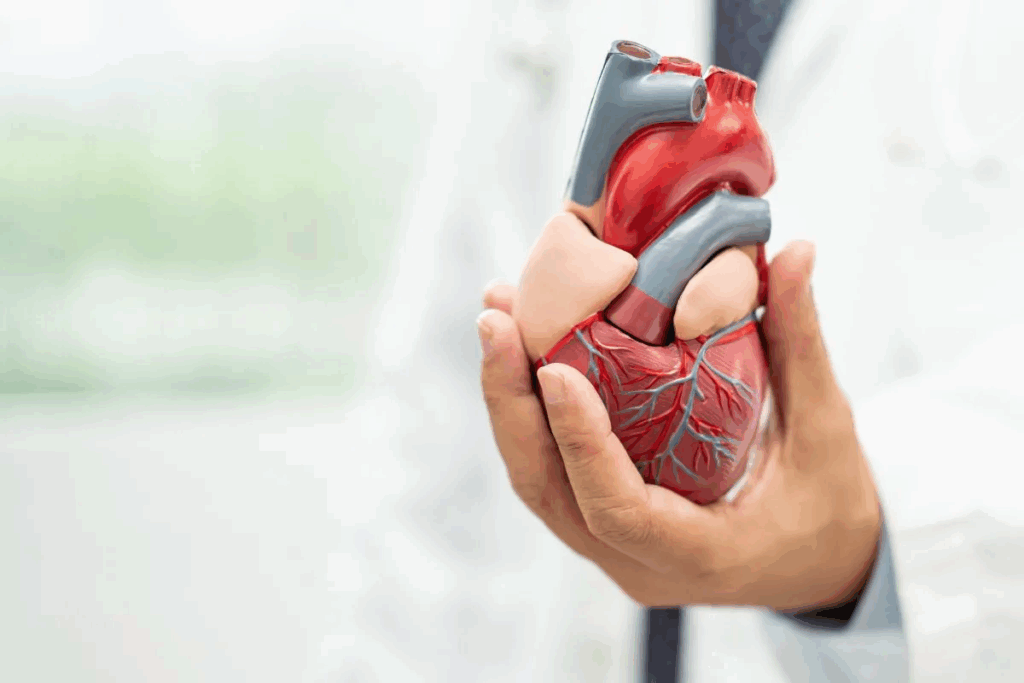Last Updated on October 31, 2025 by Batuhan Temel

Discover how to treat angina, including symptoms, diagnosis, and effective medication steps.
Angina is a condition where you feel chest pain or discomfort. This happens when blood flow to the heart is reduced. It’s a sign of coronary heart disease and means you’re at higher risk for heart attacks. It’s important to manage angina symptoms well to avoid more serious heart problems.
At Liv Hospital, we focus on top-notch healthcare for international patients. We treat angina with lifestyle changes, medicines, and sometimes surgery. We tailor our approach to each patient’s unique needs.
Getting a quick angina diagnosis and the right treatment is key. We stress the need for early action and care that fits each person. This helps improve results for those with angina.

Angina is a condition where chest pain happens because the heart doesn’t get enough blood. It affects millions of people, mostly those over 40. This pain is a sign that the heart muscle isn’t getting enough oxygen-rich blood.
To understand angina better, it’s key to know its different spellings and related terms. Common misspellings include angena, anfina, agina, and agenia. These all mean the same thing.
The right spelling, angina, comes from the Latin word for “to choke” or “to strangle.” This shows the tight feeling in the chest during an angina episode. Knowing the correct term helps find the right info and diagnosis.
Angina can happen at any age, but it’s more common over 40. Risk factors include smoking, high blood pressure, high cholesterol, and a family history of heart disease. Knowing these helps prevent and catch it early.
Other risk factors include diabetes, obesity, and not being active. Recognizing these can help lower your risk and keep your heart healthy.
Angina affects men and women differently. Men often get it earlier, but women’s risk goes up after menopause. Both men and women should be aware of their risk factors.

Knowing what causes angina is key to managing it well. Angina happens when blood flow to the heart is reduced. This is often due to coronary heart disease.
The heart needs a steady flow of blood and oxygen to work right. If the coronary arteries get narrowed or blocked, the heart doesn’t get what it needs. This leads to angina. The main reason for this is atherosclerosis, where plaque builds up in the arteries.
Several conditions can raise the risk of getting angina. These include high blood pressure, diabetes, and high cholesterol. These can make the coronary arteries narrower, cutting down blood flow to the heart.
| Underlying Condition | Effect on Angina |
| High Blood Pressure | Increases the workload on the heart, requiring more blood and oxygen. |
| Diabetes | Damages blood vessels and nerves, affecting blood flow. |
| High Cholesterol | Contributes to plaque buildup in arteries, narrowing them. |
By knowing these causes and conditions, we can handle angina better. This helps lower the chance of more serious heart problems.
It’s important to know the signs of angina to get help quickly. Angina symptoms can vary from person to person. It’s key to understand these differences.
Men usually feel chest pain or discomfort first. This pain feels like a squeeze or pressure in the chest. It can also spread to the arms, back, neck, jaw, or stomach.
Other signs include shortness of breath and feeling very tired.
Women often have different symptoms than men. While chest pain is common, women might also feel pain in the neck, jaw, or throat. Sometimes, they might not even feel chest pain.
Women might also feel dizziness, nausea, or extreme fatigue.
Knowing these differences is vital for both men and women to get the right medical care. We’ll look at these differences and their effects in the next sections.
Knowing the signs of an angina attack is key to managing it well. An angina attack happens when the heart muscle doesn’t get enough oxygen-rich blood. This usually happens because of coronary artery disease. Understanding what an angina attack feels like can help you act fast and get medical help when you need it.
An angina attack often starts with chest discomfort or pain. This pain might feel like pressure, squeezing, or fullness. It can also spread to other areas like the arms, back, neck, jaw, or stomach. This pain usually happens when you’re active or stressed and goes away with rest or medicine.
Some people might also feel shortness of breath, fatigue, or lightheadedness during an attack. These symptoms can be different for everyone and might not always show up. Knowing these signs is important to spot an angina attack right away.
An angina attack can last anywhere from 5 to 15 minutes. The pain can be mild or very strong. Sometimes, the discomfort is quick, lasting just a few minutes. Other times, it can go on for longer.
If your angina symptoms last more than 15 minutes or are very severe, like trouble breathing, dizziness, or nausea, you need to get medical help right away. Knowing how long and how bad your symptoms are can help you decide what to do next.
It’s a good idea to keep track of your angina attacks. Write down when they start, how long they last, and what might have triggered them. This info can help you manage your angina better and make any needed changes to your treatment plan.
It’s important to know the different types of angina to manage and treat it well. Angina is chest pain or discomfort, but it’s not just one thing. It has several types, each with its own signs and meanings.
Stable angina is the most common type. It happens when you exert yourself or get stressed, but it goes away with rest or medicine. The pain is usually the same every time.
Unstable angina, on the other hand, is unpredictable and can happen when you’re not even doing anything. It’s a serious sign that you might be having a heart attack.
Here’s a table showing the main differences between stable and unstable angina:
| Characteristics | Stable Angina | Unstable Angina |
| Predictability | Predictable, often triggered by exertion | Unpredictable, can occur at rest |
| Duration | Typically short-lived, relieved by rest or medication | Can be prolonged, not always relieved by rest or medication |
| Severity | Usually consistent in severity | Can vary in severity, often more severe |
Variant angina, also known as Prinzmetal’s angina, happens when the coronary arteries spasm. This reduces blood flow to the heart and can cause pain at rest. Microvascular angina affects the small blood vessels of the heart. It can cause long-lasting chest pain that might not get better with nitroglycerin.
Key Features of Variant and Microvascular Angina:
It’s vital for doctors to know the different types of angina to treat them right. Understanding each type helps manage symptoms better and lowers the risk of serious problems.
To figure out if someone has angina, doctors look at their medical history, do a physical check, and run tests. It’s key to get a correct diagnosis to plan the right treatment.
The first step is a detailed check and looking at the patient’s health history. We check their symptoms, lifestyle, and past heart issues. This helps us find out what might be causing the angina and what tests to do next.
We also do a physical exam to find signs of heart disease or other issues that might be causing the symptoms. This way, we make sure we consider everything when we make a diagnosis.
There are several tests to confirm angina and see how serious it is. These tests help us understand the heart disease and find the best treatment.
The American Heart Association says these tests are key to figuring out if someone has angina and how bad it is. “Early diagnosis and treatment of angina can greatly improve outcomes and quality of life for patients,” they say in their guidelines.
“The diagnosis of angina pectoris is mainly based on the clinical history, with the characteristic chest pain being the hallmark symptom.” –
American Heart Association
| Diagnostic Test | Purpose | Key Findings |
| Electrocardiogram (ECG) | Records heart’s electrical activity | Abnormal rhythms, signs of ischemia |
| Stress Test | Monitors heart during exertion | Heart function under stress |
| Heart Imaging Tests | Provides detailed heart images | Structural damage, abnormalities |
| Coronary Angiography | Visualizes coronary arteries | Blockages, narrowing |
By using the results of these tests, the patient’s medical history, and the initial check, we can accurately diagnose angina. Then, we can create a treatment plan that helps manage symptoms and improves the patient’s quality of life.
Treating angina requires a mix of lifestyle changes, medicines, and sometimes surgery. We’ll look at how to manage angina well.
Quick action is key during an angina attack. Nitroglycerin is often used to widen blood vessels and boost heart blood flow.
People with angina should always carry nitroglycerin. Knowing how to use it correctly is also important.
Managing angina long-term means making lifestyle changes and using medicines. Lifestyle changes like quitting smoking and eating healthy can help a lot.
Doctors might prescribe beta-blockers or calcium channel blockers. These drugs help by lowering blood pressure and easing heart work.
In some cases, surgery like angioplasty or coronary artery bypass grafting (CABG) is needed. It helps improve heart blood flow.
We help patients create a treatment plan that fits their needs and health.
Managing angina often involves using various medications. These drugs help ease symptoms, improve life quality, and prevent serious complications. They are key in treating angina effectively.
Fast-acting meds offer quick relief during an angina attack. The most used is nitroglycerin. It relaxes blood vessels and boosts blood flow to the heart. Nitroglycerin is taken under the tongue or as a spray. It starts working fast, easing angina pain.
Other quick-acting meds might be given in certain cases. Always follow your doctor’s advice on how to use them.
Preventive meds are for long-term use. They aim to lessen angina attacks’ frequency and severity. Here are some examples:
These preventive meds are often combined. They are chosen based on the patient’s medical history and angina type.
An angina attack can be scary, but knowing what to do can help you stay calm. It’s important to have a plan when you feel angina symptoms.
Here are steps to manage an angina attack:
If your symptoms get worse after taking medicine, get medical help right away. Don’t wait if you have severe chest pain or other bad symptoms.
It’s key to know when to get help. You should get medical help if:
Doctors say getting help fast is very important for angina. Knowing how to react can really help your health.
Being ready and knowing how to act during an angina attack can help manage it. Always talk to your doctor for advice on dealing with angina.
Lifestyle changes are key to managing angina and boosting heart health. By living healthier, people can cut down on angina episodes.
Dietary modifications are a big part of managing angina. Eat more fruits, veggies, whole grains, and lean proteins. Avoid saturated fats, trans fats, and cholesterol. Omega-3 rich foods like salmon and walnuts are great for your heart.
A good diet needs to be matched with regular physical activity. Exercise boosts heart health, lowers stress, and keeps weight in check. Aim for 150 minutes of moderate exercise, 75 minutes of vigorous, or a mix, each week. Brisk walking, cycling, or swimming are great choices.
Always talk to a doctor before starting new exercises, even more so if you have health issues. They can guide you on the best exercises and how hard to do them.
Stress management is also vital for angina control. Stress can cause angina, so managing it is key. Try meditation, yoga, and deep breathing to lower stress.
Also, hobbies, time with family, and enough sleep help reduce stress. It’s about finding what works for you and making it a daily habit.
By making these lifestyle changes, people with angina can manage their condition better. They can live a better life and lower the risk of serious problems.
Not treating angina can lead to serious problems. It can affect your quality of life and long-term health. Untreated angina can cause more severe and dangerous conditions.
Untreated angina raises the risk of heart attacks. This is because the heart disease causing angina gets worse. Prompt treatment is key to avoid these risks.
Angina means the heart isn’t getting enough oxygen. Without fixing the problem, it can get worse. This can lead to heart attacks or other serious heart issues. Studies show managing angina well can lower the risk of more heart problems.
Untreated angina can greatly reduce your quality of life. Symptoms can make everyday tasks hard, causing discomfort and worry. Even simple things can be tough, affecting you and your loved ones.
The fear of angina attacks can also make you less active. This makes life less fulfilling. We stress the need to manage angina through lifestyle changes, medicine, and treatments to live a better life.
Knowing the dangers of untreated angina and acting early can help. There are ways to manage it. We urge those with angina to work with their doctors to find the best treatment plan.
Managing angina well is key to a good life. Knowing the symptoms, how it’s diagnosed, and treatment options helps people take charge. They can make smart choices about their health.
Dealing with angina means using medicine, changing your lifestyle, and getting regular care. We talked about different ways to handle symptoms. This includes quick relief and long-term plans.
When angina is well-managed, people can live active and happy lives. A healthy lifestyle, following doctor’s orders, and regular check-ups help. This way, they can lower the risk of serious problems and feel better overall.
Angina care is more than just treating symptoms. It’s about keeping your heart healthy. By working with doctors and making smart lifestyle choices, people can improve their angina care. This leads to a better life.
Angina is a condition where the heart doesn’t get enough blood. This leads to chest pain. Treatment includes lifestyle changes, medicines, and sometimes surgery.
Symptoms include chest pain or discomfort. This pain can spread to the arms, back, neck, jaw, or stomach. Men often feel classic chest pain, while women might have different symptoms.
An attack feels like a tightness or pressure in the chest. It might also cause shortness of breath, fatigue, or dizziness. The pain’s intensity and length can vary.
Doctors first evaluate you and review your medical history. They then use tests like an electrocardiogram (ECG) and coronary angiography. These tests check the heart’s function and look for blockages.
There are several types, including stable, unstable, variant (Prinzmetal’s), and microvascular angina. Each type has its own characteristics and implications.
Doctors use fast-acting nitrates for immediate relief. They also prescribe preventive medicines like beta-blockers and antiplatelet drugs. These help manage symptoms over time.
Eating healthy, exercising regularly, managing stress, and quitting smoking are key. These changes help reduce risk factors and improve heart health.
Untreated angina can lead to heart attacks. It also affects quality of life by causing ongoing symptoms and limiting physical activity.
Stop what you’re doing, rest, and use fast-acting nitrates as directed. If the pain doesn’t go away or is severe, get medical help right away.
Yes, angina can signal coronary artery disease. This increases the risk of heart attacks and other heart problems if not managed.
With the right treatment, including medicines and lifestyle changes, many people with angina can live active and fulfilling lives.
National Center for Biotechnology Information. (2025). How to Treat Angina Symptoms Diagnosis and Effective. Retrieved from https://pmc.ncbi.nlm.nih.gov/articles/PMC6523058/
Subscribe to our e-newsletter to stay informed about the latest innovations in the world of health and exclusive offers!
WhatsApp us